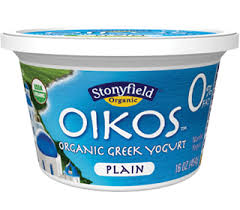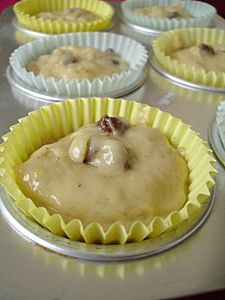After you've finished your peanut butter, rinse it out well and save
the jar and the LID. It works really well when it comes to mixing your
dry ingredients in a "jiffy". Simply measure out your ingredients
into the jar, put the lid on and then shake away.
It's great because there is no dust, no mess, no extra bowl to wash
and you already bought the peanut butter, use it as double duty!
April 18, 2011
Light, Regular, Nonfat, Greek, Frozen...
Yogurt.
What exactly is yogurt and what's the difference between them all?
Yogurt is a dairy product that is made from fermenting milk
with a bacteria. Good bacteria of course- otherwise known as
yogurt cultures. Generally speaking, lactose (sugar found mostly in milk)
is mixed with the yogurt cultures and then it produces lactid acid-
which acts on milk protein to give it- it's texture and it's slight tang
in plain yogurt before all the fruit, nuts and fancy things are
added to or with it.
Cow's milk is most commonly known in making yogurt but, yogurt
is also made from water buffalo, goats, sheep, yaks and camels.
There is also non-dairy yogurt typically known as
Soya Yogurt which is made from soy milk which is
made from soy beans.

Dairy yogurt is made by heating the milk to first kill off any
bad bacteria- followed by the milk being cooled and then the bacteria
(cultures) being added for the fermentation process which can be
anywhere from 4-7 hours.
As far as the light, regular and nonfat types of yogurt...
those are obviously determined by the type of milk that is used,
whole milk, skim, etc...
Sometimes a stabilizer, like a gelatin might be added to
ensure firmness usually which is referred to as "blended" yogurt-
most commonly known as custard like the ones served at
Rita's Water Ice www.ritasice.com or other water ice shops.
 Greek yogurt is made slightly differently-
Greek yogurt is made slightly differently-
it has been filtered out by a cloth or filter and has a higher
culture content than the average yogurt making it slightly
thicker and healthier but also can be a little more tart at times. Without all the other technical terms and processes of yogurt-
Without all the other technical terms and processes of yogurt-
you basically want to try to eat yogurt that contains
active yogurt cultures and that isn't heat-treated yogurt...
for heat treated yogurt has been heated after culturing and
thereby destroying all the beneficial and live yogurt cultures
that is beneficial for aiding in digestion.
We can think about it like this-
1 serving (about 8oz) of plain low-fat yogurt provides us
with about 400 milligrams of calcium, whereas an 8oz glass
of milk gives us about 300 mg of calcium.
Yogurt also provides us with as much potassium as
a banana and as much protein as an egg.
Enjoy your YOGURTing!
What exactly is yogurt and what's the difference between them all?
Yogurt is a dairy product that is made from fermenting milk
with a bacteria. Good bacteria of course- otherwise known as
yogurt cultures. Generally speaking, lactose (sugar found mostly in milk)
is mixed with the yogurt cultures and then it produces lactid acid-
which acts on milk protein to give it- it's texture and it's slight tang
in plain yogurt before all the fruit, nuts and fancy things are
added to or with it.
Cow's milk is most commonly known in making yogurt but, yogurt
is also made from water buffalo, goats, sheep, yaks and camels.
There is also non-dairy yogurt typically known as
Soya Yogurt which is made from soy milk which is
made from soy beans.
bad bacteria- followed by the milk being cooled and then the bacteria
(cultures) being added for the fermentation process which can be
anywhere from 4-7 hours.
As far as the light, regular and nonfat types of yogurt...
those are obviously determined by the type of milk that is used,
whole milk, skim, etc...
Sometimes a stabilizer, like a gelatin might be added to
ensure firmness usually which is referred to as "blended" yogurt-
most commonly known as custard like the ones served at
Rita's Water Ice www.ritasice.com or other water ice shops.
 Greek yogurt is made slightly differently-
Greek yogurt is made slightly differently-it has been filtered out by a cloth or filter and has a higher
culture content than the average yogurt making it slightly
thicker and healthier but also can be a little more tart at times.
you basically want to try to eat yogurt that contains
active yogurt cultures and that isn't heat-treated yogurt...
for heat treated yogurt has been heated after culturing and
thereby destroying all the beneficial and live yogurt cultures
that is beneficial for aiding in digestion.
We can think about it like this-
1 serving (about 8oz) of plain low-fat yogurt provides us
with about 400 milligrams of calcium, whereas an 8oz glass
of milk gives us about 300 mg of calcium.
Yogurt also provides us with as much potassium as
a banana and as much protein as an egg.
Enjoy your YOGURTing!
April 14, 2011
Ready, Set , MUFFIN! + 10 minutes

Almost every single time I bake muffins I notice that there is
extra batter and I always end up tossing it out because I don't
want to bake another round of muffins with barely 2 or if
I'm lucky with 3 muffins in a muffin tin of 12.
So I recently discovered what to do with the extra batter!
Fill the foil or paper liners that you normally cook your muffins
or cupcakes in as if you're going to make more but instead put
them into the freezer either in the muffin pan if you have room
or even on a small plate. Once the uncooked muffin batter is solid,
take it out and just put it into a zip lock bag.
When you've had a looooong day from work and you want your
favorite muffin/cupcake without the hassle of making an entire batch-
just take out a ready to go muffin or 2 and bake it following the time
of your recipe adding 10 minutes to the time due to it being frozen.
It's best if you have a smaller convection or toaster oven you can
bake in due to the fact you are only baking a few muffins rather
than your regular sized oven...
But, if you've had a bad day at work.... maybe it doesn't matter-
STRESSED backwards is DESSERTS ya know.
April 13, 2011
Lemons On The Grill
on your hands to get rid of strong smells like fish or even oil.
But, 2 ways to use lemons on your grill are:
when you are getting ready to grill- cut a lemon in half,
stick a fork in it and rub the lemon all over your grill grates
as the grill is warming up... this will help clean
your grates and it also gives your food a little lemony flavor
which usually works with many foods. Another of many ways
to use lemon on your grill is for salt.
Take some coarse sea salt and mix with lemon zest.
This lemon sea salt is great to sprinkle on some fish,
some types of steaks and on chicken. Add some extra
lemon juice and black pepper and you've got a simple
lemon pepper chicken.
Soak & Double Those Skewers
The most common skewers are the wooden bamboo skewers.
When you are using wooden skewers- the most important
tip is that you want to soak them in a water.
Soak them for at least 30 minutes. If you're
really in a hurry... you might be able to get away with 20 minutes-
but I really recommend 30 minutes or more. Soaking them in
water prevents them from burning when you grill them.
If your not grilling- don't worry about the soaking.
You can put any type of meat on bamboo skewers.
You can also skewer veggies and even fruit.
When you skewer smaller items that are going to be grilled...
use 2 skewers so that the food doesn't spin when you
try to turn the skewer over- especially when it comes to shrimp.
When you are using wooden skewers- the most important
tip is that you want to soak them in a water.
Soak them for at least 30 minutes. If you're
really in a hurry... you might be able to get away with 20 minutes-
but I really recommend 30 minutes or more. Soaking them in
water prevents them from burning when you grill them.
If your not grilling- don't worry about the soaking.
You can put any type of meat on bamboo skewers.
You can also skewer veggies and even fruit.
When you skewer smaller items that are going to be grilled...
use 2 skewers so that the food doesn't spin when you
try to turn the skewer over- especially when it comes to shrimp.
Here Fishy, Fishy, Fishy...
beware of soggy seafood. Fresh fish should be firm and shiny,
not slimy or soggy.
If you are buying the whole fish rather than a fillet-
you want to look your fish in the eye, making sure the eyes
are clear which indicates a recent catch and freshness.
Cloudy eyes in fish usually indicate that it's been on the
shelf for many days. Fresh fish should be vibrant and
almost glistening to the touch. Fishy fish is also not good.
Even though you are buying FISH... if it smells fishy...
don't buy it. It has gone bad. Don't buy fish or seafood that
is being offered at a bargain either... unless you are getting
a bucket of something by the shore somewhere-
seafood usually isn't going on sale unless it's getting older
and the store wants to get rid of it. Save the sales for the shoes!
April 11, 2011
Compost Your Scraps!
I have this silver little one that stays on the floor by
the trash can. and a 2nd one... a metal bucket with a
lid from Ikea.com which is bigger but still small enough
for an apartment.
I started one in the winter, by simply taking soil from
3-4 old plants that had died from freezing from being
on my balcony. And I started to add raw scraps from food.
The most common things that go into my compost are-
carrot & potato peels, egg shells, tea bags, coffee grinds,
onions skins and fruits that might go bad.
My soil in these composts have turned the soil very dark,
rich and healthy... I'm just waiting to get some plants to use my
recycled soil that is full of nutrients.... hmmm what
kind of herbs should I plant....?
Just make sure your bucket has a lid. A lid that will be
tightly sealed. There are many different types of composts...
for example some people actually buy bugs/worms to add
so the vegetation breaks down even more quickly...
I've found that you don't have to do that... just make
sure your lid is closed on your bucket and leave it alone...
just take a little shovel and mix the soil after about
2-3 weeks of decay. Don't be surprised when you take a
sneak peak in a week or so... just remember the soil is breaking
down and the food and it is decaying.
Subscribe to:
Comments (Atom)


